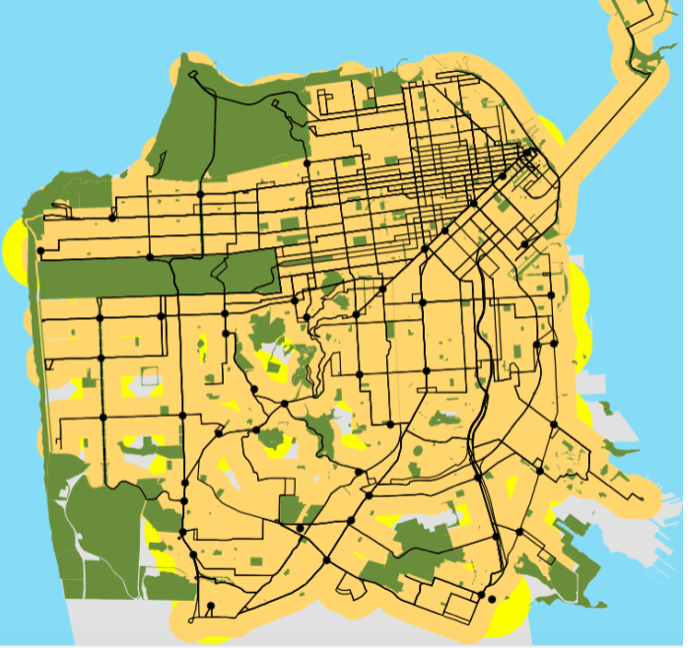Pretty much everybody who’s paying attention to the housing crisis in San Francisco – except, apparently, the Chronicle – is talking about the new study by eminent economic geographers Andrés Rodríguez-Pose and Michael Storper that argues against looser zoning rules as a solution to the housing crisis.
Even Richard Florida, who used to love the idea of cities attracting the young “creative class” (before he discovered gentrification) says the study is important. It’s the latest in a series of studies that challenge the notion that allowing the private market to build more housing will bring down prices.

In that sense, it’s a direct challenge to Sen. Scott Wiener’s SB 50, which seeks to deregulate housing in large counties.
Storper and Rodríguez-Pose start by debunking the proposition that the solution to economic inequality is to encourage more low-skilled and underpaid workers to move to vibrant, growing cities where they can find work:
According to this dominant view within economics, relaxing zoning and other planning regulations in the most prosperous cities is crucial to unleash the economic potential of cities and nations and to facilitate within-country migration. In this article, we contend that the bulk of the claims of the housing as opportunity approach are fundamentally flawed and lead to simplistic and misguided policy recommendations.
They describe the mainstream economic argument that there’s no value to place, and that struggling cities can’t be save so everyone should move to somewhere like San Francisco, which should grow as necessary to accommodate that migration.
And they say that it’s fundamentally flawed:
The basic set-up here derives from spatial equilibrium theory, which holds that city size and population growth are the only important factors for economic growth, because once the conditions are in place for population growth, jobs and output growth will follow (Glaeser, 2008). This model explicitly rejects using income, per capita income, or the wage structure as measures of urban performance.
Then they get into the SB 50 argument, which relies on the old-fashioned economic assumption that supply and demand are the only real factors that affect price, and therefore more housing supply will automatically bring prices down.
But:
housing markets are not like standard markets, so that aggregate increases in supply do not translate in any straightforward way to decreases in price, because the internal plumbing of housing markets – succession, migration, and occupation patterns – are full of frictions, sunk costs, barriers and externalities that make the effects of aggregate supply increases highly uneven, and in many cases involve unintended or contradictory effects.
In fact, they argue, in a city like San Francisco, relaxing zoning controls to allow more density will likely have the opposite effect: Existing vulnerable communities will be displaced to further suburbs, while housing prices will remain high in the city.
That’s the exact opposite of what a strange article in The Nation says. In the story, Benjamin Schneider suggests that the only opposition to SB 50 comes from rich homeowners who support exclusionary zoning. Actually, in San Francisco, pretty much the entire organized tenant movement and nearly every social-justice organization in the progressive community opposes Wiener’s bill. Those groups say, like Storper, that the Wiener approach will make the housing crisis worse.
The main reason: The housing that the market will provide is not going to help lower-income people who face the pressures of gentrification.
we now argue that policies such as blanket upzoning, which will principally unleash market forces that serve high income earners, are therefore likely to reinforce the effects of income inequality rather than tempering them … There is virtually no evidence that substantially lower costs would trickle down to the lower two-thirds of households or provide quality upgrading of their neighbourhoods, but it undoubtedly would enhance displacement in neighbourhoods currently at the boundary of higher-income inner metropolitan areas. Indeed, according to Zillow data reported in The Washington Post (August 6, 2018), rents are now declining for the highest earners while continuing to increase for the poorest in San Francisco, Atlanta, Nashville, Chicago, Philadelphia, Denver, Pittsburgh, and Washington, noting that a boom in luxury construction in these areas has failed to ease housing market competition for cheaper properties.
They argue that increased market-rate housing drives up land values and brings higher-income people into one-inexpensive neighborhoods:
In any event, all types of lower-income households in prosperous regions pay the price of ‘displacement’ in competing with higher-wage workers who benefit from upzoning to gentrify neighbourhoods, as they occupy its newer, higher quality housing.
The two authors suggest that public policy aimed at increasing housing affordability require public subsidies and regulation – and a process for funding the subsidies. In California today, Gov. Newsom is sitting on a $25 billion budget surplus, while the housing crisis and homelessness are among the most pressing issues facing the state. That kind of money could make a huge difference: Even half of the surplus, targeted for affordable housing in major cities – could be used with local and federal matches to create tens of thousands of new social housing units, enough to make a serious dent in the crisis.
Combined with the repeal of the Ellis Act and Costa-Hawkins, which prevent effective rent-control and eviction protections, and commercial rent control, which would protect existing community-serving businesses, California could move strongly to reduce gentrification and displacement.
But those are regulation-and-subsidy moves, that don’t seem to have much support in what has become the mainstream of policy thought in this state.
Storper and Rodríguez-Pose also worry that all this focus on growth in prosperous cities ignores the regions that are left behind –places that, with some government assistance and economic development, could once again be successful communities.
In the end, they directly take on the Wiener approach:
It is our view that too much is being promised to policy-makers about the supposed potential benefits of housing market de-regulation. At the same time, in the rush to promote an oversimplified vision of “densify near transit stops”, too little consideration is being given to the policies that would promote affordability for the right people in the right places.
SB 50 is moving forward in the state Legislature. Critics all over the state (including tenant groups and economic justice advocates in cities, not just the rich suburbs) are organizing against it.
Storper will be in San Francisco Thursday/30 for a presentation on the Wiener bill. It’s called “Why Scott Wiener’s SB 50 will not get us affordable housing: The new trickle-down economics – build for the richest 30 percent and cross your fingers for everyone else.” The event is free and open to everyone. It starts at 6:30pm in the Rainbow Room at the LGBT Center, 1800 Market.





